As Setswana language was spoken around me, the gift* of Botswana envelope me. It didn't take long. Within the ardor of Francis Kudumo, our guide and tracker for the next twelve days, a part of Africa lay before me.
Born in the village of Xakao in the northwest close to the Namibian border, his presence was one of calmness encased in an aura of self-assurance and knowledge. Apprehension never pierced my confidence in him. His eyes lit up and focused on every question about the land, the animals and his country. Participation in any humorous story or unlikely scenario overcame any barrier of language.
At one point during our excursion, I asked Francis, "What is the essence of Africa?"
He paused, making me wonder if the question had been asked before, or never asked. His steady demeanor of accommodation to tourists and their urgings to label experiences, came out. "Africa is a place of many different regions, many different people and many languages," he said with a shake of his head.
His answer made me realize the ridiculousness of asking the question and I never did again. Africa is a continent of analogous people interspersed in a myriad of color, of sand and water, of mountains and old volcanos, of the Great Rift Valley and a collection of wildlife some believers see as a semblance of what heaven may offer.
Touching down in Zambia was a beginning of a documentary under my own narration. Throughout the trip I attempted to let Africa speak for itself. I wanted to feel what I was in rather than ask questions about it. I wanted no measure of superiority. This was a Black country, as was Botswana; I was a privileged white American that lost his country's special place in the world.
Toka Leya
Passage through Livingstone, Zambia, at one time capital of white-ruled Northern Rhodesia, in a tourist designed bus conjured a picture of a frenetic frontier town — people and dust going somewhere, in mind of something, people on foot, on bicycles, in small trucks, all dealing with an unemployment rate above 60 percent. Yet vexation wasn't in the air. This was the gateway to Victoria Fall or Mosi-oa-Tunya (The Smoke that Thunders) on the Zambezi River separating Zambia and Zimbabwe.
My lodge at this camp (and subsequent camps) was a large tent framed by a wood structure with comfortable necessities, set above ground on logs, connected to an elevated wooden pathway leading to other lodges and an eating and gathering open-air large room with bar and vista of the river. Named Toka Leya — luxury by bush standards — the camp hugged the Zambezi River. On the other side was Zimbabwe, and not far down river mist from Victoria Falls hung high above the tree cover. Rainbows a frequent occurrence.
Botswana food is excellent, proven so here and at every camp our group visited. Biltong was particularly tasty, made with various types of air-dried cured meat, including local game such as ostrich and kudu. Chefs delivered a pre-dinner presentation, and did so proudly, followed by a local sommelier making recommendations for this or that South Africa wine. Sometimes hovering about was a slingshot-armed camp member alert to keep the vervet monkeys at bay from sealing a bite.
The Zambezi current did not waver as it moved toward the falls. Fast in shallow water, slower in deeper water as the dry season was just beginning. Later during a boat ride hippos disappeared and reappeared in pools by the riverbank as the boat came closer. A small crocodile, barely on land, took in the sun, and colorful bee-eaters, one of nine species, fluttered in and out of their nests in holes on the sandy riverbank.
At Toka Leya bushbucks frequent the surrounding riparian woodland. The small, near dainty antelope, usually seen in the early morning, could be seen resting under the lodges during other hours. The bushbucks had little to worry about in becoming a big cat's meal. Predatory animals, outside of a wandering leopard, are not found in the area, Francis said.
Victoria Falls/Mosi-oa-Tunya National Park
Following the footpath to various observation points at the world's largest waterfall can silence conversations, water spray a constant feeling stroke of its presence and the sound of its power appropriate to mark African greatness. Too challenging to an older couple in our group was a walk across a bridge connecting two islands in front of the falls. Ponchos and a steady gait are required in facing the daunting onslaught of water.
David Livingstone was the first European to see the Victoria Falls rainbow. As a Scottish explorer, abolitionist and missionary, maybe he took it as a divine sign that would carry him onward in his search for the source of the Nile. Europeans praised his accomplishments after his death leading to an influx of other missionaries seeking god-like work in Africa. Unexpectedly such zeal led European leaders to eyeing the continent for colonization. Such a derisive conclusion did not dampen African affection for Livingstone. His heart was buried in Africa after his death in 1873 and later his body taken to the coast by native friends. A statue of Livingstone stands outside the entrance to Victoria Falls, guarded haphazardly by a troop of baboons.
The falls were first formed by the actions of the earth as plate tectonics and volcanic activity broke apart the single continent of Pangaea; the "Big Spill" (as geologists call it) happened some 15 million years ago uniting the formerly two Zambezi River systems. The falls may be altered again in 5-10 million years as the Great East African Rift Valley splits, creating a Nubian plate and Somali plate as part of the African continent separates and a new body of water and coastline is formed.
Few animals have suffered more at the hands of man's greed than the rhino. And the attacks continue. At the Mosi-oa-Tunya National Park the placid appearance of two white rhinos allow visitors to walk among them as the great beasts convey a sense of resilience and sadness. Lack of predatory animals in the park allows observation from the ground. Human encroachment forces the building of fences not only to protect the rhinos but the elephants, giraffes, zebras, wildebeests, baboons and other animals living in the park. Zambia seeks to reinforce its tourism business by rebuilding its ecological offerings to visitors. When the tourists leave, guards with AK-47s remain and follow the rhinos as they wander the park, companions 24-7.
"If we were not here, they would be dead in one day," a guard remarked.
Sinde
A village some kilometers from Livingstone, Sinde likely was chosen by Francis for a visit. It was in keeping with an itinerary from Natural Habitat, World Wildlife Fund, the designer and organizer of our 12-day African trip. Here was a place of people rather than animals except for chickens, dogs and goats, and an occasional lumbering herd of elephants coming through at night.
Julia, a tall, stately woman, in a colorful dress, was our village tour guide. Hers was a refined manner. Her English was exemplary, not a hint of condescension or a beseeching for her plight or her village.
"I was born here. I live here," she said in a self-respecting way, adding that Sinde was where she would stay.
Two large, enclosed pens for chickens were a source of food and income for village members. Julia pointed out the small market, a large covered outdoor hearth, dwellings with thatched roofs and metal roofs, the village gathering spot and a government provided water source. There was no plumbing or electricity.
With various termite mounds dotting the village expanse, Julia said a concrete-like paste can be made from it as a building material and the mounds can denote family boundaries. It is also used in traditional medicine.
Francis called termites a "keystone species" throughout our trip, noting the African termites differ from the North American related insect in recycling dead wood, help create hollows when building that catch water for other animals, and can be homes for mongooses and red and yellow barbets (birds).
When Julia introduced the village headman to our group he had been playing Nsolo, a type of Mancala count and capture game dating back thousands of years.
Before him and another villager were a series of scooped holes in which small stones or nuts were used as game pieces. He did not speak as he stood to greet us but his persona seemed to mirror hers. Next to his game area was a curio stand of handmade goods, jewelry, and colorful weave baskets.
As headman he is the village's primary decision maker and resolves disputes. Though the Zambian village governing structure is usually patriarchal, Julia appeared to have influence in Seide.
Chobe River/Linyanti
It wasn't until I was on a boat on the Chobe River, away from the tourist hub of Kasane, did I begin to absorb the splendor of Botswana and the sublime blessing given to its people. Looking south to the Chobe National Park, I saw upsloping hills speckled with acacia trees and elephant-loving mopane trees. To the north flooded islands led to Namibia. A playground for hippos.
Overhead, a multitude of birds flew, landed, ambled along and African skimmers raced ahead of our boat. The birds were like paintbrushes, back and forth eliminating dullness, keeping the cloudless sky a vibrant blue.
On the park's shore vultures picked on the remains of a buffalo, so said Francis. A trio of elephants kept ahead of a trailing boat, their backsides pointed at disappointed camera-bearing tourists. Impalas crowded the shore to drink, alert of what was around them. It was a majesty held by every curious child.
A single-engine plane took us southwest to the Linyanti Camp, toward the Okavango Delta and along the Linyanti River, landing on a strip of sand and clay mixture (and maybe some termite material) in the miombo woodlands of scrubs and grassland. After a slow, bumpy, sandy, trench-battling drive, an experience one woman in the group called an "African Massage," we reached Linyanti overlooking a riverine swamp stretching north to south to the river. It was a mecca for thirsty terrestrial animals and water-loving creatures. The weather was exquisite, masking the expected nighttime winter cold expected this time of the year south of the equator.
Arriving late in the day, we were given our lodge numbers and began to acclimate to our temporary home. Looking west from an elevated chair-and-firepit space, across the swampy area, the spread of papyrus, bulrush grasses gave home to the shy semi-aquatic antelope, the Sitatunga. Reeds swayed in the wind pointing the way to the savanna leading to Namibia as bee-eater birds held on to the tall stems swinging back and forth. As the daytime faded the coming sunset became an unavoidable commanding presence. In the dimming light, a camp staff member pointed out a grazing hippo about 20 meters from us. The grunts now were obvious.
The night sky opened to stars not seen to those above the equator. Francis, using a strong laser light, pointed out the Southern Cross, a prominent constellation in the Southern Hemisphere that can be used for navigation. That led to a question from one of the women in our group as to which Crosby, Still, Nash and Young song we liked. We all had different favorite songs.
That night the hippos began their chorus, communicating with one another and active at night while coming to shore to eat. There, the hippos can call out a variety of oboe-like sine waves of sounds in volumes that have been measured at 115 decibels. We were not in a human neighborhood.
For a group of unexpecting white, American suburbanites, hippo talk can be unnerving. The next morning I mentally measured the distance from the swamp to the front of my lodge. It wasn't far. I consoled myself by deciding a hippo's thick stubby legs would prevent him from getting up onto the narrow porch.
Early the next morning after breakfast we began our trek. Riding into the woodland Francis followed animal tracks on the rutted, sandy bush lane. We kept our cameras handy. It wasn't long before the noise from our slow-moving Toyota safari truck rousted nearby animals.
Elephants were common giants. Environmental engineers, they sometimes stood out among the smashed and broken mopane trees with the females quickly moving away when they had youngsters. Feisty juveniles would poke their heads through mangled trees and open their enormous ears as if their bluff would shoo us away. Botswana has the largest elephant population in Africa and shuns culling the herds. Their hope is that they would move northwest back into Angola where a civil war and land mines had decimated previous elephant numbers.
Impalas seemed around every turn. Giraffes could be spotted but one had to look up. Helmeted guineafowl and their chicks scampered away from our vehicle’s wheels. Here and there zebras, curious but wary. Marabou stocks would cluster in an open area. Warthogs quickly scurried away when they spotted us. Their short legs covering ground and their upright antenna-like tails signaling where they are going. Tough to photograph even as the women in the group voiced their fondness for them. Closer to the swamp we saw more impala moving onto the grassland with waterbucks and red lechwe antelope. If Francis saw tracks of a lion or leopard he didn't say. That night I heard a lion roar in the distance. Or was it a leopard? Or just another hippo?
The following day Francis confirmed a lion was in the area. "He's signaling he's here," said Francis.
Back in the safari vehicle we looked right and left as the machine plodded along. Every so often Francis would drive off track to the left, lean over the right-hand driver's seat door, and study tracks in the sand. At one point we heard the lion roar and it appeared to be answered by another more distant roar.
"They can be heard up to five miles (8 kilometers)," said Francis.
The drive became a little more frantic, moving toward the lion's sound while Francis continued to examine the ground for tracks. As we approached the wooded ridge overlooking the swamp we came to an opening. Francis called out, "There he is!"
A large male lion, scars marking his back, was breaking across the grassland in confident strides heading to the swamp area. "He must be covering ground 10 feet at a time," said the older man in our group.
In a near blink the lion disappeared into the woodland. We drove toward the area we thought he had entered the bush. No one spoke. After a while Francis drove past the swampy area and down onto the grassland. In the distance a herd of impala all faced one direction, frozen in place. They were spotters for Francis. Then we saw him to our left moving back again from where he came. He paid us no mind. We sat there taking photos and watching his silhouette fade into the landscape.
Each of us had our thoughts about seeing the lion as we drove back to camp. Then, a woman in our group, who debunks the label of a professional photographer despite her talent and worldwide travels, motioned to a tree in the distance. We strained to see what she was pointing at. Francis steered the vehicle off the worn path toward the tree. A partially eaten impala kill wedged between two branches became visible.
"He'll be coming back," said Francis.
He backed away from the tree and we slowly circled the area. A movement in the tall, dry grass caught someone's eye. The leopard had come back but was now moving away. "It's small," said Francis, "a female." We pursued her. At one point she stopped, peering at us in the shadow of a brush. All we could see was the outline of her face. Then she vanished into the African terrain.
Back at camp the talk was of the leopard and missed photos of her. Later, before we left for Pelo Camp in the Okavango Delta, in the star-filled night a lion roared, and the hippos continued their talkathon.
Pelo
The trip to Pelo was two-part, one land, another water. A Land Rover safari vehicle took us to a boat launch. The multitask Francis then piloted the flatbottom launch through a dizzying array of zigzag waterways to an island where Pelo stood. Like all of our stays the camp staff greeted us with smiles and overhead two-handed back-and-forth waves, which in Western sensibility would be a gesture for help. Not so in Botswana.
Surrounding Pelo is the Okavango Delta, a rare inland delta since its water does not empty into a sea or ocean. Part of the Okavango River basin, the delta is fed by rainfall from the Angolan highlands. Seasonal flooding peaks in June through August, the cool, dry months, where the delta can expand to 15,000 square kilometers or 5,791 square miles. Since it is primarily an oasis in an arid land, the water eventually evaporates and transpires. But this year was a good water year, said Francis, and "it's still rising." Our discovery of the delta was by boat instead of by land.
Countless islands of varying sizes mark the delta. It's estimated that 70 percent of the islands were created by termite mounds. When dry, the termites build, when the water comes they vanish. Birds drop seeds as do elephants and other herbivores, and trees begin to sprout and grow. In the Okavango Delta the termites validate their "keystone" status in this land of cycles.
When water is at its most, the delta becomes one of Africa's greatest concentrations of wildlife. Of Africa's Big Five, only the rhino is missing from the delta. Those that survived an onslaught of poaching were removed.
Increasing water levels keep the big mammals, like elephants and giraffes, moving from island to island or on the outskirts of the delta with zebras and wildebeest. The hippos and crocodiles stay in the water. Sitatunga antelope and especially lechwe can be seen bounding through the shadow water from island to island. Bridges, used by animals, have been built for movement from island to island.
The Okavango is a birders paradise. Over 500 species live or visit in the delta. The birds tested our camera skills with their constant flight-land behavior as we glided through water and attempted to match Francis' skill of identification — sight and sound. It was a game of sorts.
Color occupies a big part of Okavango birdlife. A sample seen included: the chestnut-colored African jacana, the African pygmy goose and the larger Egyptian goose, the colorful Little bee-eater and radiant relative Carmine bee-eater, the Saddle-billed stork, Slaty egret, the Malachite kingfisher and my favorite, the polyvocal Swamp boubou that when the bird called to another boubou, I had to ask Francis, "Is that one?" In almost every tall tree, an African fish eagle surveyed the water and reeds. A white-header raptor, this national bird of Zambia, Malawi, Zimbabwe and Namibia, is as majestic as the American bald eagle.
Before we left Pelo, Francis introduced us to mokoro, a. traditional poled dugout canoe giving one an eye-level exposure to delta animal residents. Polers were assigned to us to take us out into the delta but first he suggested we try it ourselves, close to camp, of course. Two women volunteered. I looked on from the deck above, deciding trying mokoro wasn't necessary to prove my masculinity. One woman gave up early, the other, our group's quasi-pro photographer and proven eagle-eye in finding game, proved pro-like in her mokoro skills, balancing herself in the rear, keeping the mokoro steady as she dipped the long pole into the water to navigate her chosen direction. I felt humbled.
Pelo, like Linyanti, offers a serenity, yet here its water-world environs drape silence everywhere amidst the innumerable sounds of animal and insect denizens. The heavyweight clutter of buildings, wires, lights, concrete coverings and persistent mechanical noise remained an irritating memory with a visit.
Our boat cut through the water to the airstrip for a flight to the southeast corner of the Okavango Delta.
Gomoti
Compared to Toya Leya, the Chobe River, the Seide village in Zambia and Linyanti, Gomoti, a 6,000-hectare (15,000 acres) community-owned reserve through the Santawani Concession, felt the most remote, a land of animals and birds where gaining insight require a respectful countenance. For my part there was a want of inclusion, letting my human oneness melt into the landscape.
The elephants do their engineering work as large trees break under their strength turning woodlands into savanna and acacia scrub. The bulls seemed larger than at Linyanti and more attentive to our presence; the juveniles playful among themselves as they followed their elders through the bush. Waterholes pockmark the land, attracting thirsty animals and at one small watering spot, a dark hump turned out to be a lone hippo in respite some kilometers from the Santantadibe River to the west.
We saw animals we had yet seen or little of — the tsessebe antelope with its long face, red hartebeest, ground hornbills, a pair of black-backed jackals keeping warm in a hole near a pile of elephant dung, bat-eared foxes appearing from an aardvark hole, one ostrich following another as they cut across in front of us as we rode along our well-traveled bush track, and the kori bustard, Africa's largest flying bird. The photographic prizes were a Narina trogan and Lilac-breasted roller, two of the world's most beautiful birds. The day did not seem long enough.
Francis seemed intent on finding predators. After speaking by radio with another guide from a different camp, he was told of a place where a cheetah was spotted moving from one termite mound to another, scouring the countryside alert for prey.
There's an enchanting aspect to this magnificent animal. She displays a sophistication more than a wildness. Black lines flow down each side of her face, pass her eyes to her mouth. Her long body and sloping back help narrate her status as the world's fastest animal. We followed along for a while then left her to fulfill her intent of finding a meal.
A nursing lioness was also on the hunt. Her turn away after making sure the cubs were hidden and fed. She may have been a member of a local pride. Other pride members were four male lions Francis had tracked nearly running over one as he turned by a large bush. His loud shriek and quick spin of the steering wheel only stirred the lion briefly before dozing off. A few meters away — as we were — three others took in the sun. The posture of a cat on its back asleep, well known to pet owners, was on display. Later we found three young lions, presumably female, exhibiting additional familiar cat gestures as touching noses to greet a companion and sleeping together with paws touching one another.
One day Francis received a radio call from another guide that his safari had found a leopard treed with a kill and cub. We found his safari watching an adult leopard as her cub ate on an impala carcass between two limbs. Mom was observing from below yet keeping an eye out for lions and hyenas that could be interested in the kill.
When eating resorted to playing with his food, the leopard cub came down to mom's side. They touched noses, she gently slapped him and they jostled about until the cub jumped away to another limb. Then the mother leopard began to pull the apala down from the tree. "I have never seen that," Francis said.
We continued to study her efforts until the impala fell to the ground behind the tree away from our view. Francis drove to the other side of the tree. There, another cub had pulled the carcass to him as he hid in the undergrowth. Now we know why mom pulled the kill to the ground.
Mother leopard approached the cub as he ate. He bared his teeth and hissed at her. "Leopard's eat alone, not like lions that eat in a group," said Francis.
The cub took advantage of his gift while the other cub watched. Eventually, the mother leopard turned her attention to us. Our vehicle was a few meters from the tree. The leopard then walked out on a limb toward our vehicle leaving an easy jump onto the roof of the safari truck. Francis quickly started the vehicle and drove some distance away.
Was he scared, someone asked? "No," he said. "She wasn't baring her teeth or hissing but I was afraid of someone panicking." None of us said we wouldn't.
The animal sighting did not end when back at camp.
Helping greet the coming day were hornbills. One or two perched just outside the breakfast area on a bush hoping for food scraps. In the late afternoon and evening, and into the night, elephants, giraffes, zebras and impalas came to drink at the camp's watering hole some 90 meters away from the camp's fire pit area. Pumped from an underground source, the camp offers its animal guests a pool of its slightly salty water for drinking beneath a dead acacia tree hung with large weaver bird nests, another African animal engineer. It was almost a Hitchcockian mystery portrait.
I spent the last day and night staring at that waterhole and the grassland and tree line surrounding it. Around me was a vast intelligence. Wanting not to leave was a dream-like urge. Botswana is a beautiful land, its people wonderous in their generosity, wisdom and friendliness.
It is easy to romanticize my experience. My cynicism crushed under diversity of life encircling me, my hesitation to relate diminished by Francis, the lesbian married women of our group and the doting care of a husband to his frail wife in seeking adventure.
When I heard a Grey Go-away bird call out, I responded, "Dumelang" and "Tsamaya sentle!" (Greetings and Go Well)

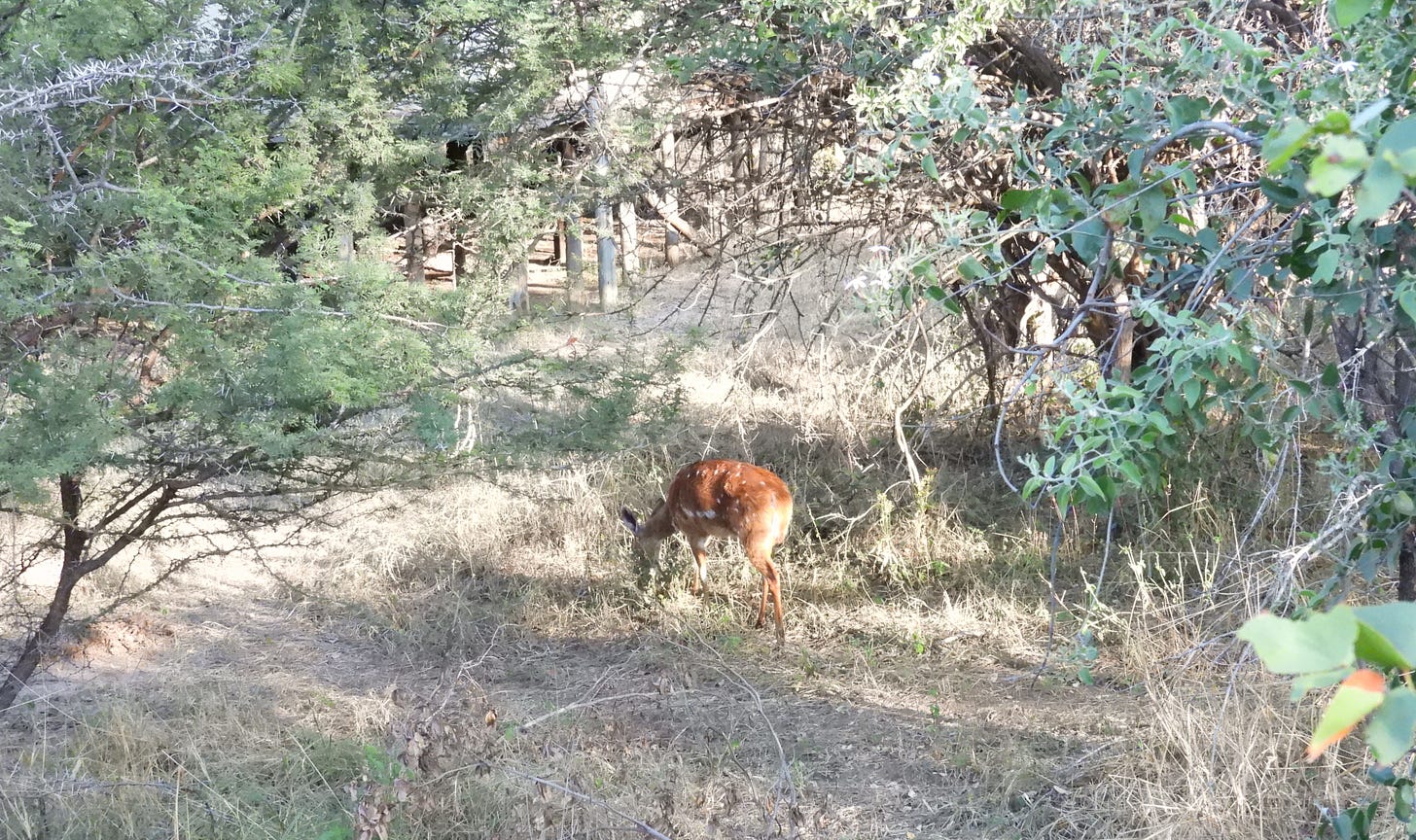
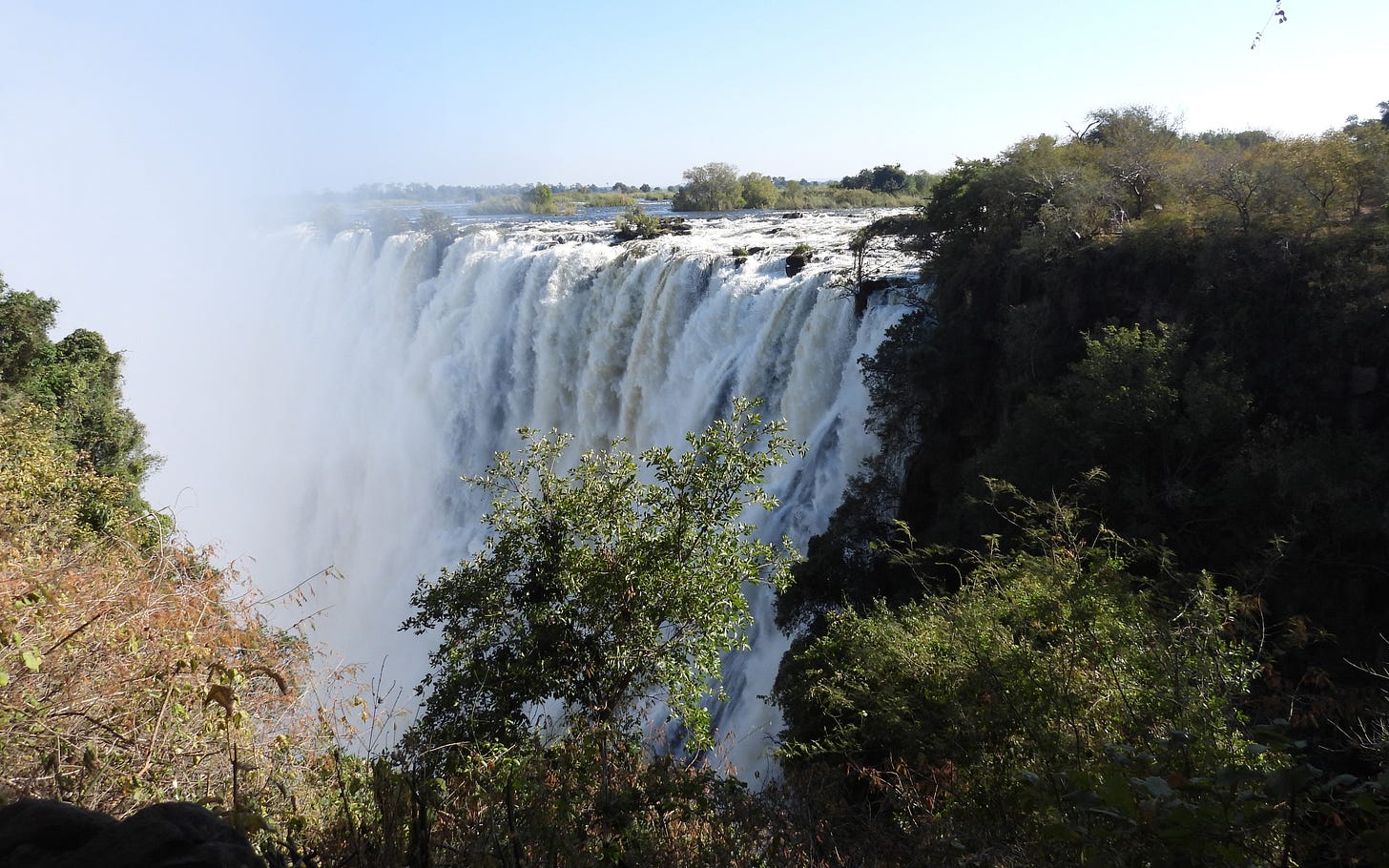

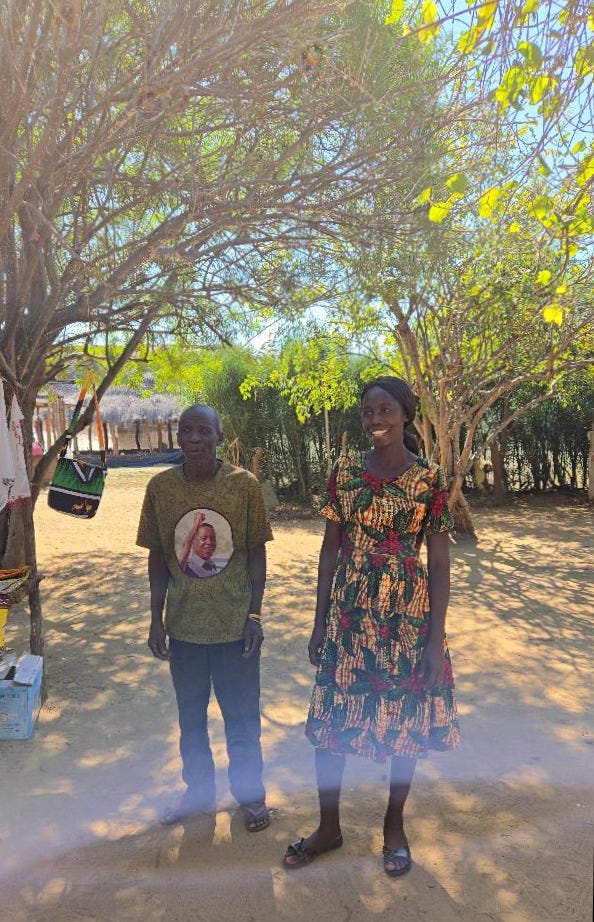
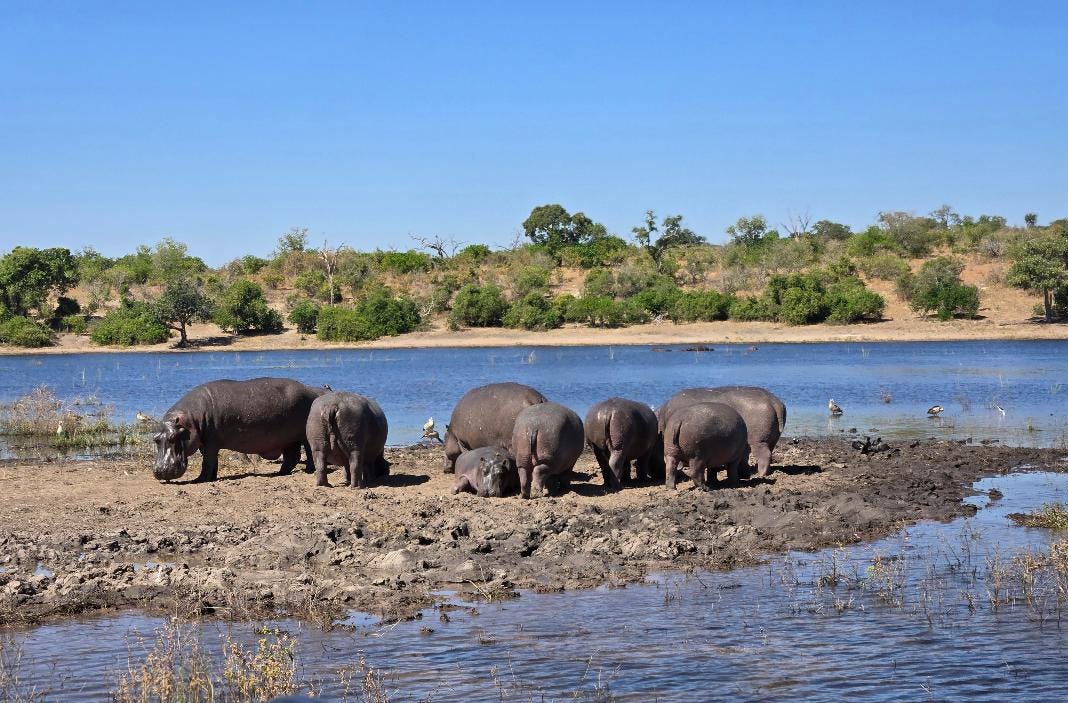
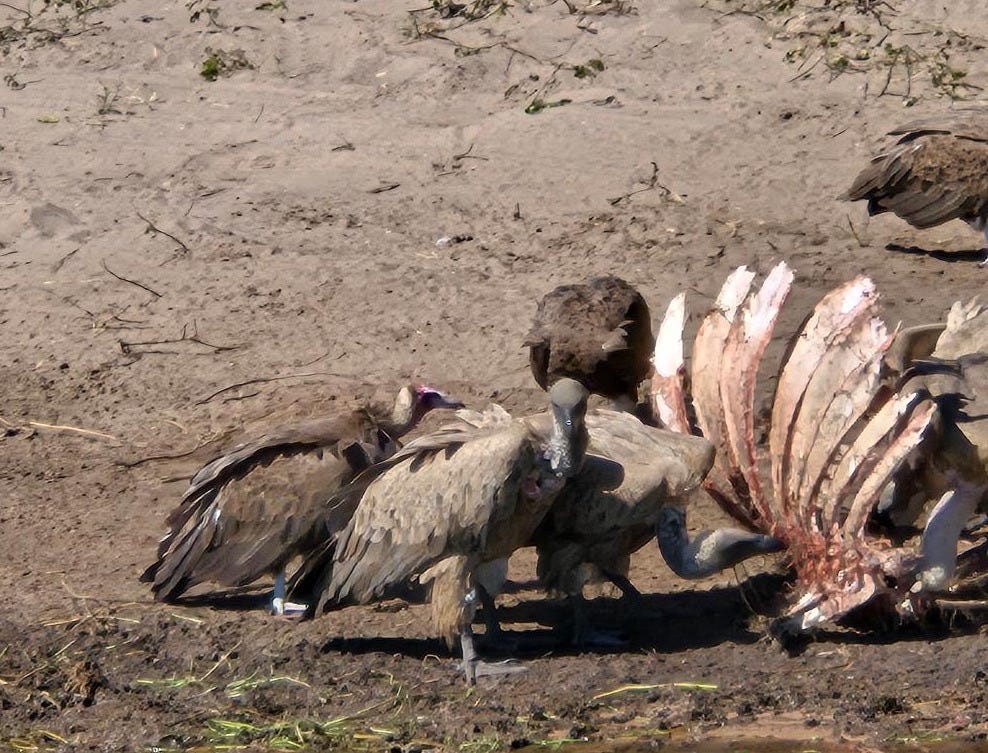
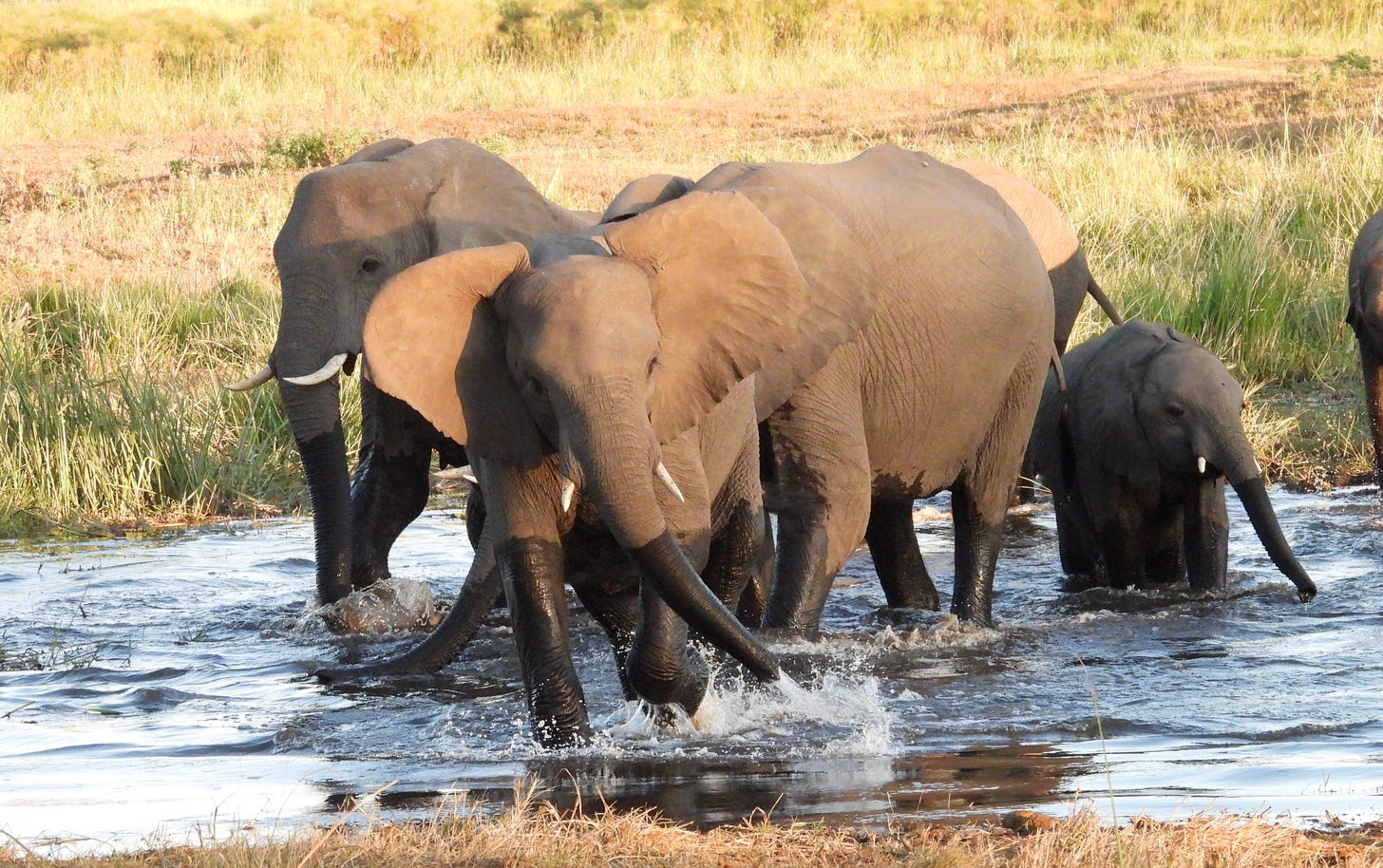

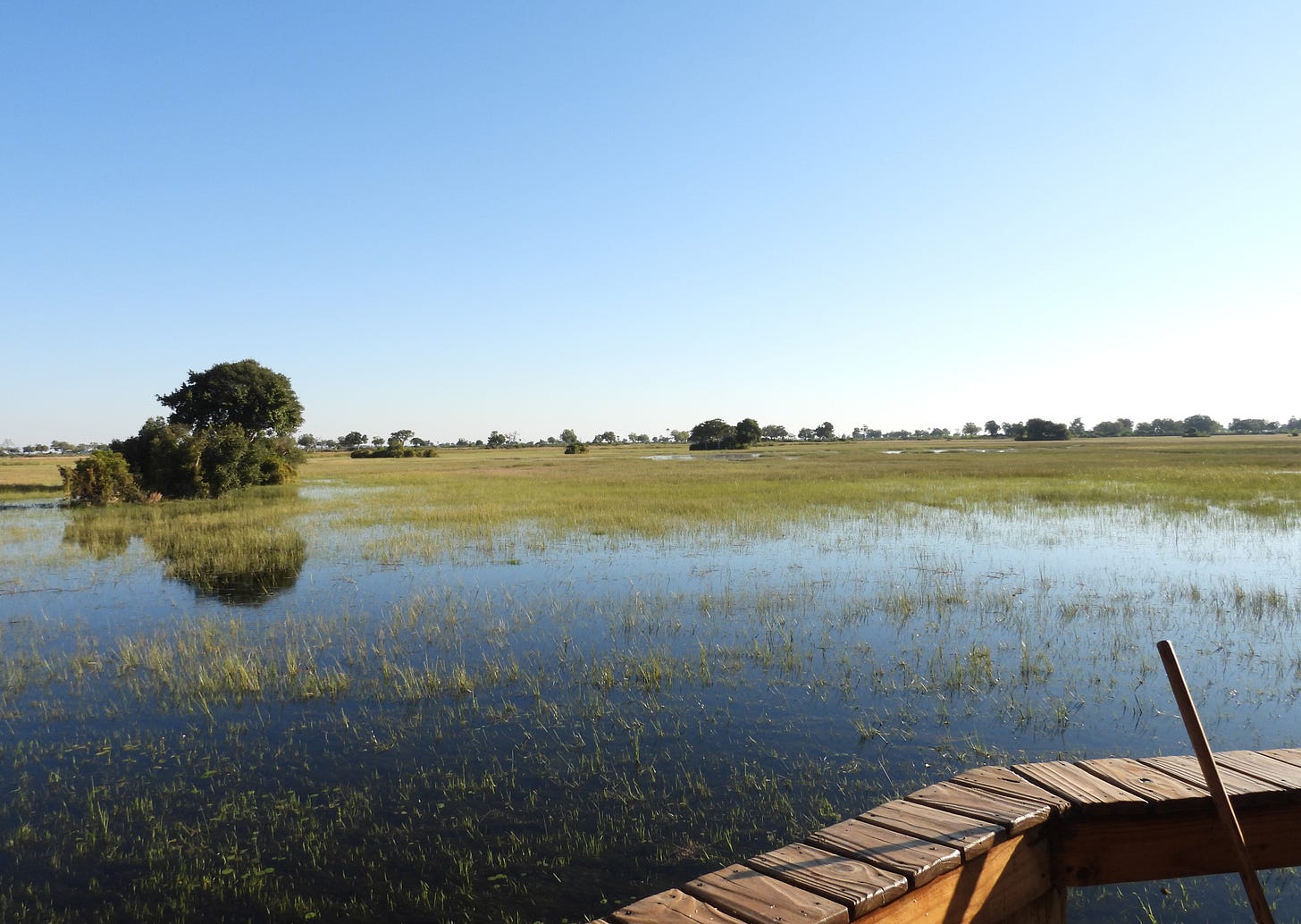

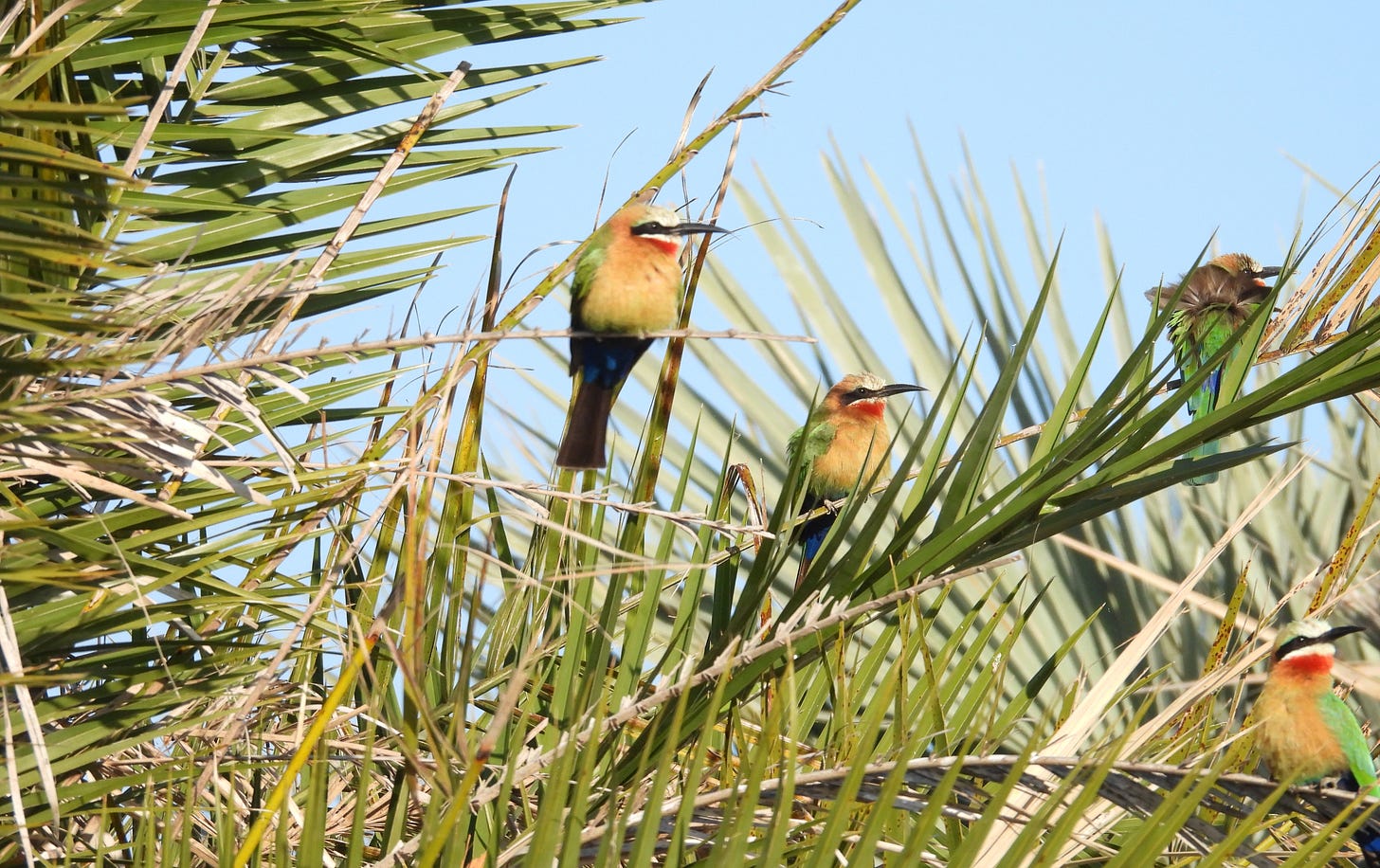


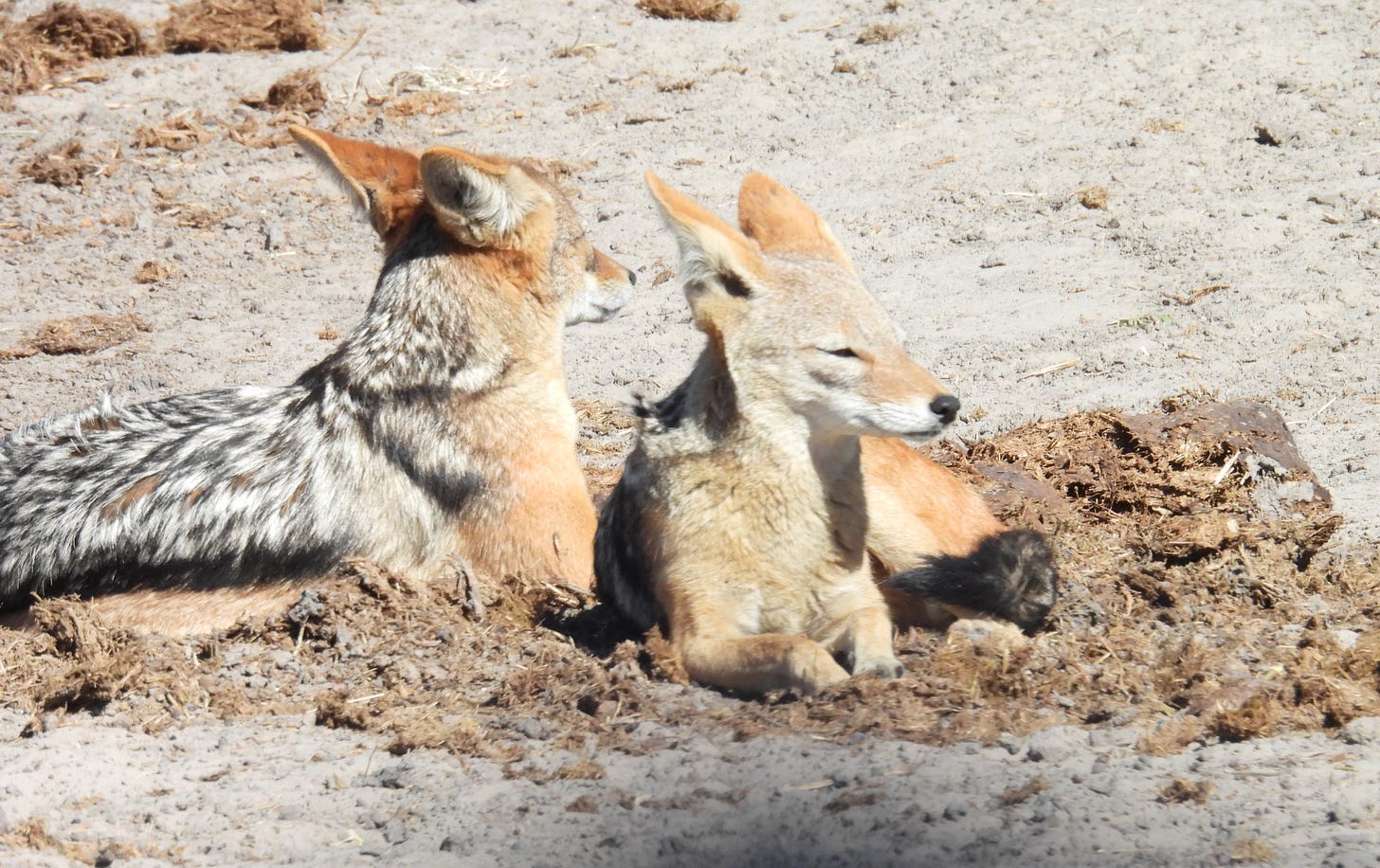
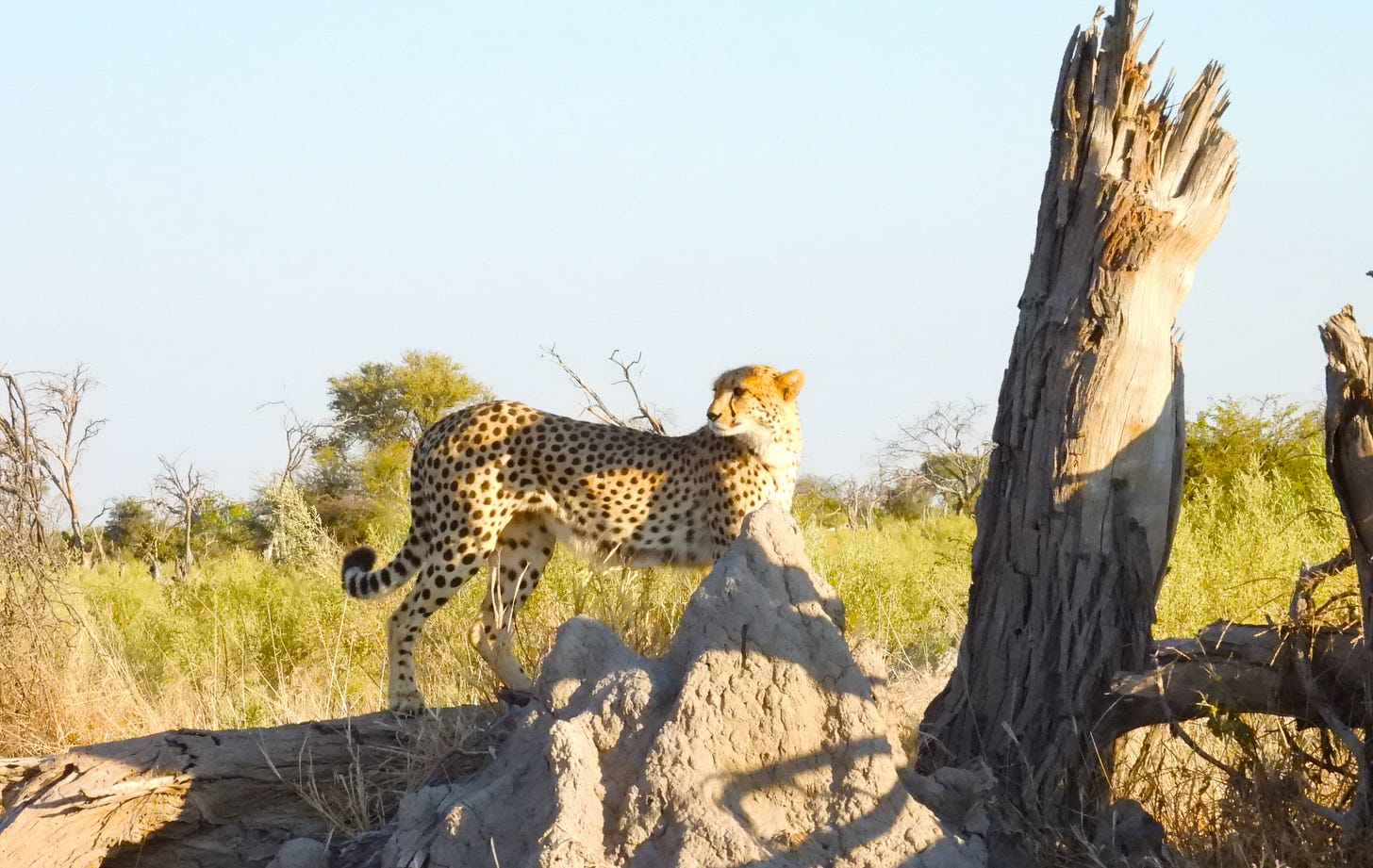
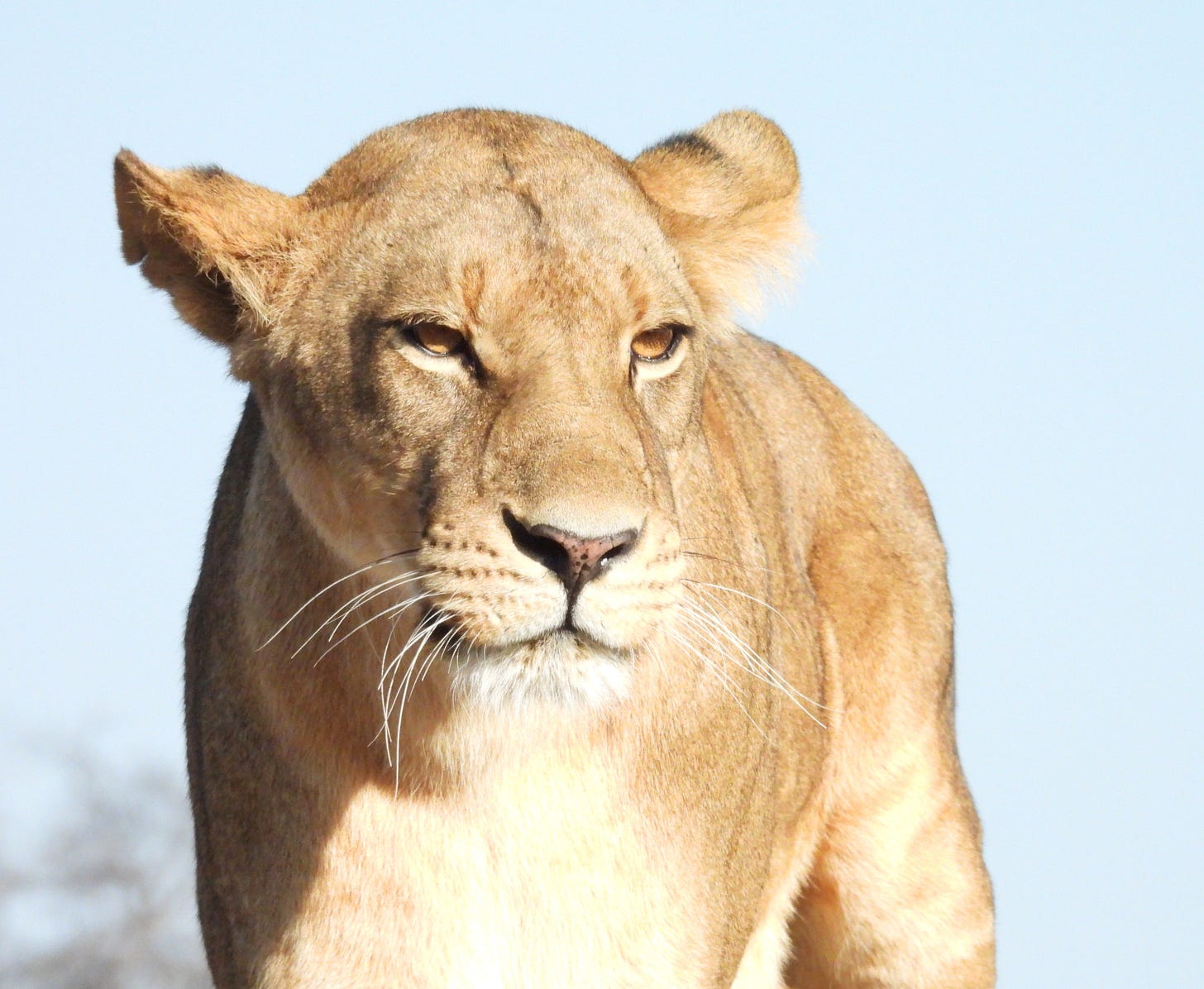

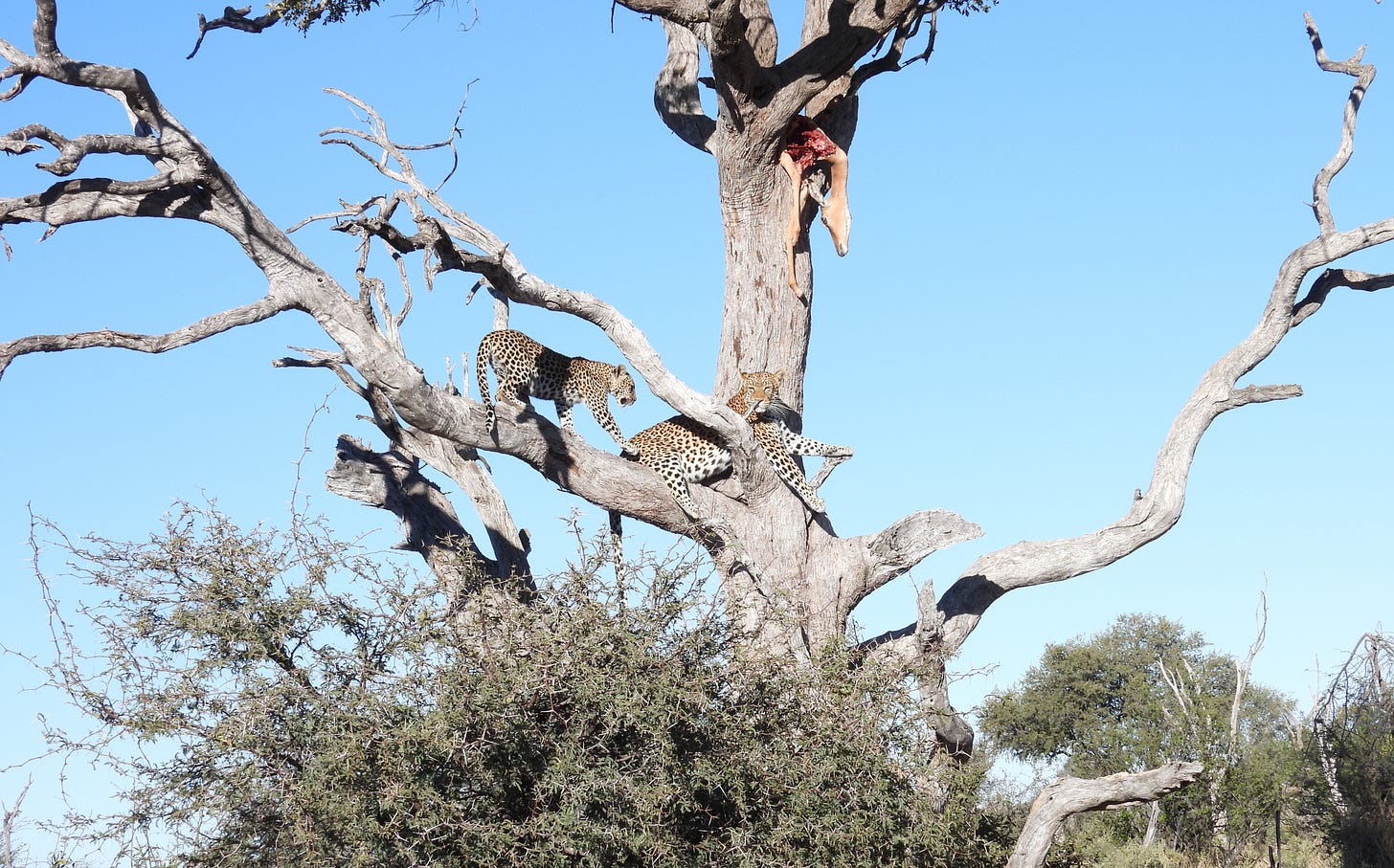
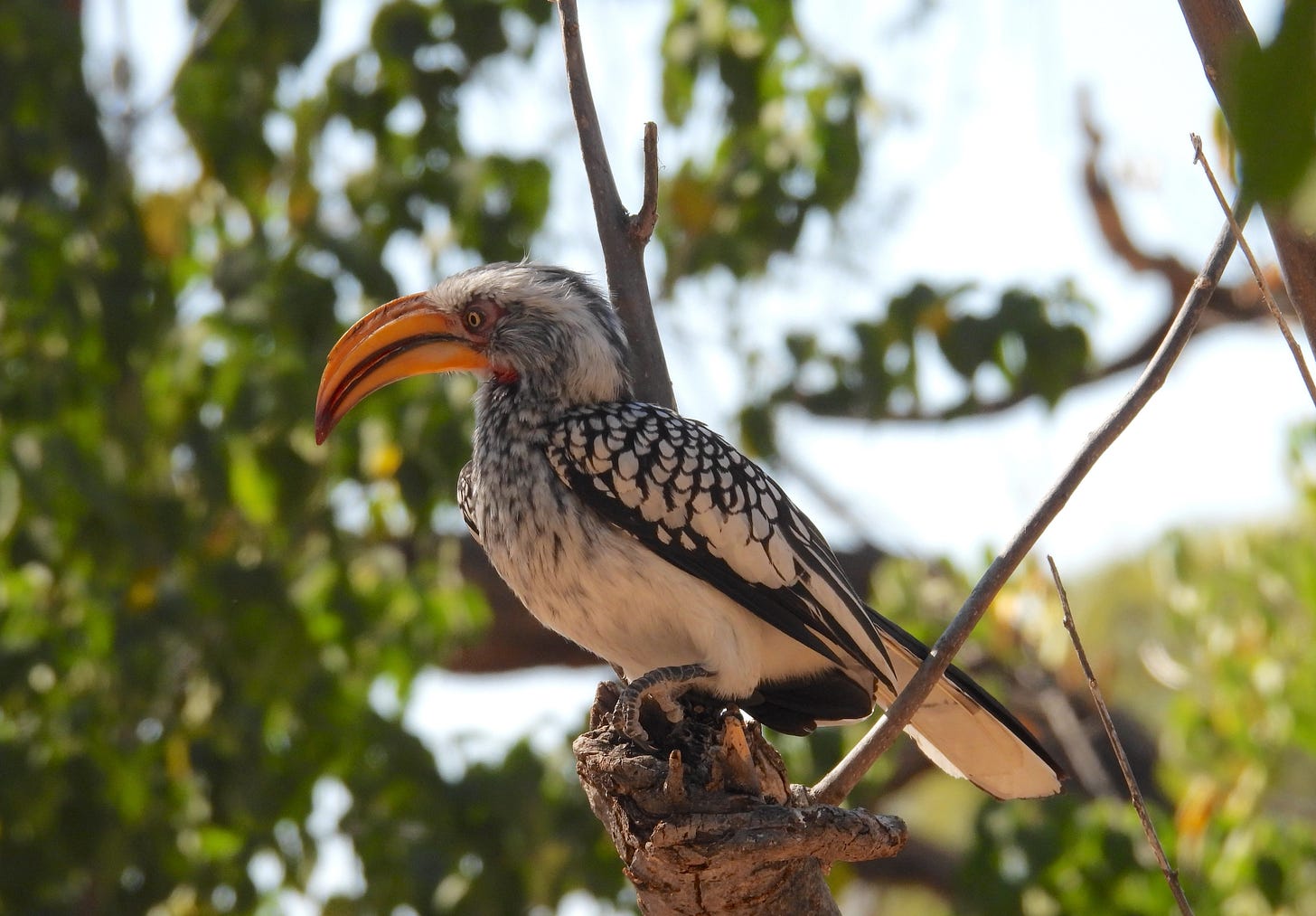
Really nice article and photos. That was quite a trip you had.